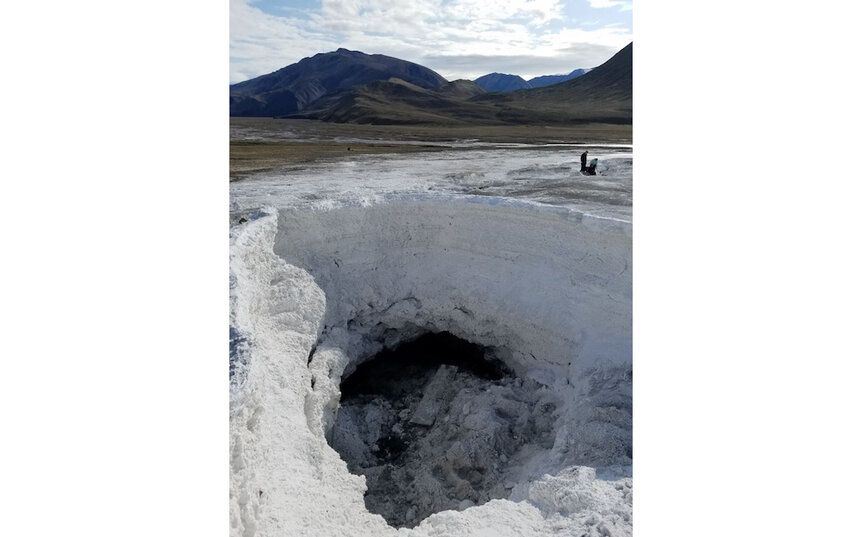Create a free profile to get unlimited access to exclusive videos, sweepstakes, and more!
How is Canada like Mars? Lost Hammer Spring shows us
Canadian microbes are a lot like what Mars life would look like.

Earth and Mars are not terribly alike. Mars is incredibly cold, the air is incredibly thin, and the chemistry on the surface is incredibly different than what you’d find anywhere here.
Well, almost anywhere here.
Lost Hammer Spring is in Nunavut, Canada, about 1,000 kilometers south of the North Pole. Conditions there are forbidding, but water still flows because it’s extremely salty, up to 24% saline, so it doesn’t freeze. The water is also anoxic, carrying as little as one part per million oxygen, frigid at -5°C, and the sediment around the spring is loaded with sulfates, as much as 10% by weight, and emits gas primarily in the form of methane.
It’s phenomenally hostile. To humans, at least. Amazingly, scientists have found microbes that thrive there. Even more amazingly, they don’t depend on oxygen or organic (complex carbon-based) molecules to survive. Instead, they take in simple inorganic molecules like methane, sulfates, carbon dioxide, and the like, and use them in their metabolism.
These are conditions and molecules that may be found on Mars, if you include the possibility that briny liquid water exists under the Martian surface. In other words, put these wee beasties in the right place on Mars, and they might do pretty well.
We don’t know if there’s life on Mars, but the best way to learn right now is to look for analogues on Earth. This seems to be the right one.
Lost Hammer Spring is what’s called a diapir, where water is forced upward through cracks in porous rocks, and conditions there are rough. Still, microbes thrive there and have been known for a while now. Previous research showed that there are anaerobic microbes there, ones that don’t need oxygen to survive, including ones that combine sulfates and methane for energy; this produces hydrogen sulfide — the chemical that makes rotten eggs smell the way they do — which is used by organisms as well.
In the new research [link to paper], scientists used sophisticated methods to analyze the life in the spring. For example, they employed a technique called metagenomics, where they collect genetic information from a community of microbes in a sample, instead of from a single species, which can be used to look at the diversity of life and make broad conclusions about the microscopic life that thrives there.
What they found is that the microbes in Lost Hammer Spring are lithoautotrophic — I love these big words; in this case that means microbes that metabolize minerals to get energy — as well as ones that use methane for energy.
They found over 100 different microorganisms in the spring, and many of them are bacteria as we usually think of them, but many are actually archaea. These, as the name implies, are an ancient form of life, one of three broad domains of microbes: bacteria, archaea, and eukaryotes. All three of these probably came from some extremely ancient organism, but diverged early on in Earth’s history.
I mention that specifically because life tends to adapt to changing situations — if it doesn’t, it dies. Life arose on Earth when conditions here were very different, and in most cases has slowly changed over the eons. We now see life everywhere, including places like Lost Hammer Springs, which cannot support humans, or most life like us at all.
Which brings us to Mars. We know Mars had water and a thicker atmosphere billions of years ago. We don’t know if life ever arose there, but it didn’t take long for life to get going on Earth, and conditions on Mars were similar. Something catastrophic happened to Mars, and it lost its air and most of its water. Looking at the surface now, it’s hard to imagine life evolving there.
But things weren’t always as they are now. If life did develop, then over time it’s possible it could have adapted to those changing conditions. And nowadays we do see conditions very similar to those at Lost Hammer Springs. Hypersaline water, methane, carbon dioxide, sulfates… the ingredients either do or are likely to exist.
If we can find microbes on Earth that need neither oxygen nor organic material to live, it’s at least possible they could exist on Mars. That’s hugely speculative, but the point is we can’t necessarily rule it out. And the metabolic processes seen at Lost Hammer are at least an analogue for how it could work on Mars, and worth studying if only for that.
We’re still at the beginning of this process, though. The scientists need to work on culturing more of the microbes to get a better understanding of their metabolism, and on the other end we need to look at Mars more carefully to see what places might have conditions conducive for this sort of life. Again, it doesn’t mean life exists now or ever did on Mars, but if we don’t do the basic work, we’ll never know, will we?




























